|

Zsuzsanna Kozák
|
|
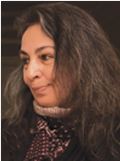
Ildikó Lázár
|
“At crucial junctures,
Every individual makes decisions,
and…every decision is individual.”
- Raul
Hilberg, Holocaust scholar
Do we notice if a person living next door is
in trouble? Do we want to notice it? Do we dare to confess to ourselves that we have something
to do with our neighbor? What does it imply that in one language the
word neighbor includes its Biblical sense (a person
for whom we have moral responsibility) while in other languages we have
two separate words for those who just live close and those about whom we
are supposed to care? Also, why do we have the concept of bystander in English when in other languages it does
not have a precise equivalent? Lacking certain words is one of the many
tremendous internal and external obstacles to communication about and
with our neighbors. How can we still speak about individual choices and
social responsibility across cultures? What’s the difference between our
current neighborhood and the community in the Germany of 1938 where
people let their neighbors’ windows be shattered during “Crystal night”?
To explore possible answers, the Visual World Foundation (VWF) has been
developing an innovative international project for 3 years now, using
the exciting metaphor of The Neighbor’s Window and building on the basic
concept of an amazing United States Holocaust
Memorial Museum (USHMM) exhibition about bystanders and the
Holocaust. We hope that the description of our project will provide you
with both inspiration and concrete activities for your classroom.
The essence of the USHMM exhibition was to approach the
Holocaust from the point of view of neighbors, onlookers, and other
ordinary individuals, instead of focusing on the perpetrators and
victims, as often done by traditional studies. This
approach seemed extremely relevant to
teaching, because it is much easier to identify with ordinary
people than with heroes and villians The distance of historical times
provides a safe environment to discuss human behavior patterns,
including the mechanisms of discrimination and scapegoating, which are
also painfully relevant topics today.
VWF launched a unique project for training
bystanders to become upstanders with six partner schools in
Hungary using some seed money from the USHMM; its own resources; and
financial, professional and human support from the Embassy of Canada in
Hungary. 243 students and 17 teachers (of English,
media literacy, history, and visual arts) and psychologists worked
together to teach about human behavior in different periods of history.
We used historical photos and videos with their descriptions provided by
the USHMM to learn about history and individuals’ role in it. The
photos were incorporated in installations by the participating students
and gave a visual and textual reflection of the situations depicted in
the original images.
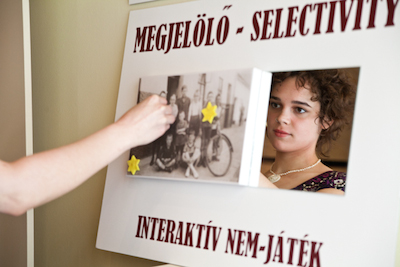
Selectivity: an interactive non-game”: The work of the Szombathely Secondary School of Art shows that labeling anyone will make us face ourselves in the end.
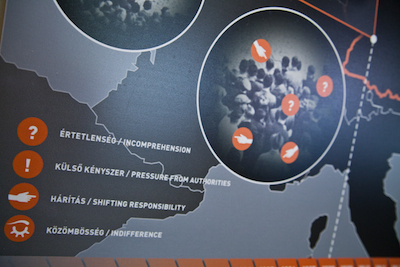
Same patterns in different places and times: The picture shows
the work of Kürt High School. There was consensus in the class: Four
patterns should be pointed out in different historical photos taken in
Germany in 1938 and in Hungary in 1943—incomprehension, pressure from
authorities, shifting responsibility, and indifference.
The uniqueness of this collaborative effort is the broad
spectrum of partner schools: from a primary school for the visually
impaired, through four different high schools (including one in the
countryside), to a university for the Reformed Church. The series of
installations created by the participating students was turned into a
mobile exhibition. It received
patronage from the United Nations Educational, Scientific and
Cultural Organization (UNESCO) in spring 2016 and since then we have
been using it as a teaching tool. The exhibition has been traveling to
different places to engage and sensitize new and sometimes not
necessarily open-minded audiences.
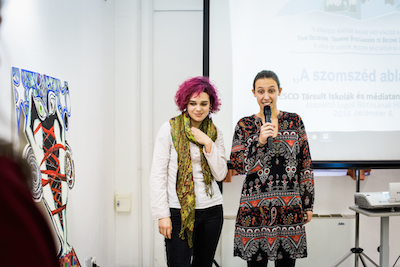
Students Kata Martincsák and Eszter Csordás passionately
introduce their installations to policymakers and teachers at a
conference.
Most of the student artists, peer guides, and their teachers
were present and contributed substantially to the success of the events
that accompanied the exhibition (Guensburg, 2016). For example, last
year at a conference for media literacy, teachers and representatives of
UNESCO-associated schools held at the headquarters of the Hungarian
Commissioner for Fundamental Rights, participants listened to the
students describe the creative phases of the project and their motives
in contributing to the awareness raising about the role of citizens in
times of crisis.
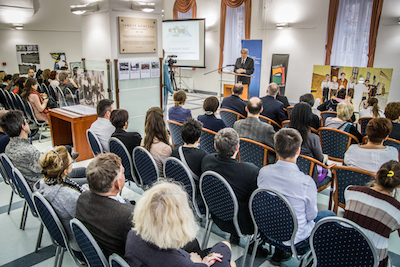
Miklós Réthelyi, UNESCO chair, gives a speech before presenting
The Neighbor’s Window project at a conference at the Office of the
Commissioner for Fundamental Rights
In spring 2018, the exhibition was hosted by the Israeli
Cultural Institute in Budapest. In the course of 3 months, five
workshops were organized to accompany the exhibition and help
disseminate the idea that we need to take the initiative and speak up
when human rights are not respected. Activities included simulations and
debates with follow-up reflections about the role of witnesses of
discrimination, the key role of speaking up for others’ rights, and the
great importance of participation in decision-making, including local
and national elections. Students, educators, NGO-representatives, visual
artists, journalists, and decision-makers all participated together.
That The Neighbor’s Window is a traveling exhibit with diverse
accompanying events depending on the local audiences’ needs and
interests contributes to its sustainability.
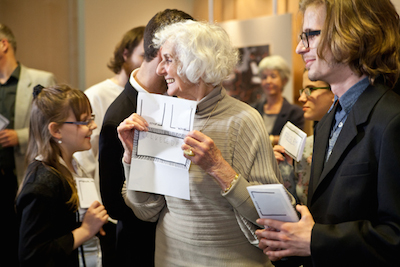
At one of the workshops, students, teachers and journalists
participated in an activity with Éva Fahidi, Holocaust survivor. Éva
suggested that we create a glossary of key terms and she cited her old
definition of a decent person: someone who always
stands up for the values of the community and never lets any of the
members be offended or attacked.
Activities for the Classroom
Here is a description of four activities from our project that
can easily be adapted to any English class with the aim of having
participants explore social issues and the nature of individual
responsibility, solidarity, and advocacy.
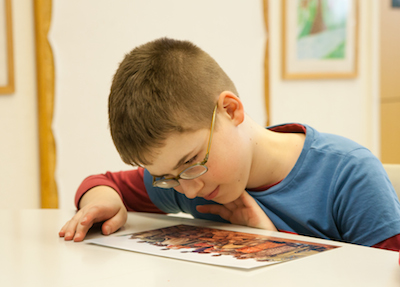
Péter Gács, a student from the Primary School for the Visually Impaired is examining a group of same-age Rwandan students to look for similarities between Rwandan children and his own friends.
1. Becoming aware of our own relationships with neighbors (conversation and map design)
Aims: This activity helps learners realize how little we know
about people living close by and sheds light on relationships and
alienation, as well as typical language use in such situations. Drawing
the map of communication channels helps explore the possibilities of
improving relationships with neighbors.
Procedure
-
Raise the following questions for pairs or groups to discuss:
-
Whom from your neighbors do you like the most? Why?
-
Whom from your neighbors do you like the least? Why?
-
Can you share a typical dialogue that happens between you and these two neighbors?
-
Which neighbor of yours knows the most about you? How does it feel?
-
How did s/he get all this information about you?
-
Ask participants to design a map by drawing the
communication channels in the group and also between the group members
and their neighbors.
-
Ask them to rewrite their dialogue with the disliked neighbor with I-messages showing more respect.
2. Better understanding and interpreting dialogues (making subtitles for a video)
Aims: This activity teaches empathy and promotes a deeper
understanding of the meaning of words and body language by practicing
respectful (accurate) interpretation and taking the spectators’ viewing
habits into consideration.
Resource: The
video introducing the USHMM exhibition serves as an excellent
medium to design dubbing and editing tasks.
Procedure
-
Ask participants to watch the video and prepare a transcript.
-
Tell them to translate the sentences, including concepts,
into their mother tongue and then shorten the text into subtitles (42
characters x 2 lines/screen max).
-
Editing the text and copying the subtitles on the video are
optional. At more advanced levels, you can screen a video in the
participants’ native language and they have to write subtitles in
English.
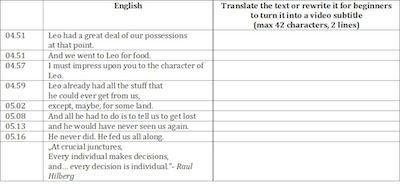
3. Neighbors’ participation in public humiliation (sharing associations/vocabulary with others)
Aims: This activity helps explore the visual language of
propaganda and invites learners to extend their vocabulary, communicate
with like-minded people, and tune in to a discussion about
inclusion.
Resource:
A video
from the website of the exhibition allows students to compare
their responses to others’.
Procedure
-
Screen the video.
-
Ask participants to open a new textbox by clicking on the Tags icon on the website.
-
Students enter a word to describe what they have seen in the video.
-
Then they can take a look at what words people from all over
the world entered when completing the same task.
4. Advocacy (discussions and cooperative
group work, adapted from TASKs
for Democracy (Mompoint-Gaillard and Lázár, 2015)).
Aims: This activity promotes equal participation, parallel
interactions, interdependence, and individual accountability and raises
awareness of the need to take the initiative and remember our
resources.
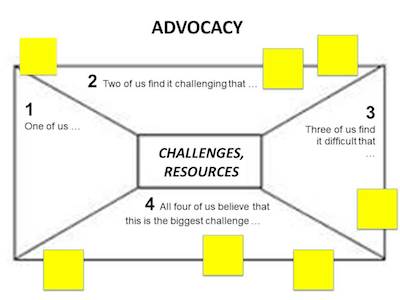
This is the “window” pattern that participants can use to sum
up how many agree on challenges and available resources in advocacy.
Procedure
-
Put participants in groups of four and have them draw a
window on a large sheet of paper. Write the topic in the center, and
divide the window into four panels.
-
Ask participants to individually think of a group of people
they (would like to) represent in society to help them let their voice
be heard.
-
Then have them think of all the challenges they face when trying to speak up for this group.
-
Instruct them to individually write a list of these
challenges in just a few key words, and mark on their lists the two most
difficult ones.
-
Ask participants to take turns at the table to share these
most difficult challenges and count how many in their group face the
same difficulties.
-
Have participants write these challenges into the
appropriate panel in the group’s window according to how many of them at
the table share the same difficulties.
-
In the next 10 minutes, encourage groups to add resources
they could count on when trying to overcome these challenges. These are
added to the windows on yellow Post-its to make the posters visually
brighter as well as more positive and motivating.
-
Finally, pin the windows to the walls, and have the groups
present the challenges and resources in advocacy.
Conclusion
What helps us speak up for our neighbors? How can we best
represent the rights of a group of people? How can we ensure that our
voice is heard? What are the challenges we need to overcome in advocacy?
As the motto at the beginning of this article says, it depends on us
individuals what we do with the neighbor’s window. Perhaps none of us
would break it intentionally but we might not notice if our neighbor is
unwell behind that window. It may be a useful strategy to occasionally
knock on that window and start a conversation.
Developing empathy, promoting solidarity, sustaining meaningful
conversations through art, and language learning activities are the
focus of our complex educational project entitled The Neighbor’s Window.
We are grateful to Lydia Stack and Elisabeth Chan for having presented
our project at TESOL Conventions in their sessions entitled,
respectively, “Bystanders Becoming Upstanders: Media Literacy Education
for Secondary ELL Students”(2017, Seattle, Washington, USA) and
“Creative Media as Tangible Advocacy for Global Educators” (2018,
Chicago, Illinois, USA).
We are also thankful to Rosa Aronson, former TESOL executive
director, and Dudley Reynolds, former president of TESOL, for the letter
they sent to all TESOL members on 31 January 2017. Their speaking up
for international students and teachers clearly and eloquently followed
TESOL values, which gave our core team in Hungary an injection of
braveness. The public
statement they made was a great example for an upstander’s
actions that we were lucky to witness at the right moment during the
development of our experimental project in a moderately supportive
environment.
We would be delighted to receive offers to host the exhibition
and the accompanying workshops. Please contact us at neighbors@visualworld.org
if you would like more information. Photos: Judit Kocsis, VWF
References
Guensburg,
C. (2016). Holocaust lessons inspire Hungarian students’ art.Voice of
America. Retrieved from https://www.voanews.com/a/holocaust-lessons-inspire-hungarian-students-art/3298721.html
Mompoint-Gaillard, P., & Lázár, I. (Eds.) (2015). TASKs for
democracy: 60 activities to learn and assess transversal attitudes,
skills and knowledge. Pestalozzi Series 4. Strasbourg: Council of
Europe. Retrieved from https://www.coe.int/t/dg4/education/pestalozzi/Source/Documentation/Pestalozzi4_EN.pdf
Zsuzsanna Kozák is a media literacy education
advisor and a documentary filmmaker—with this background, a passionate
TESOLer. She is the founder and executive director of a Budapest-based
NGO, Visual Word Foundation, which produced several educational
documentaries for teachers of English and peace educators starring
former TESOL presidents (e.g., Philotimo
and Teaching
Tolerance Through
English).
Ildikó Lázár is a
senior lecturer at Eötvös Loránd University, Hungary, offering courses
on English language teaching methodology, cultural studies, and
intercultural communication. She has also worked as a researcher,
materials writer, and facilitator in many Council of Europe projects.
She has been coordinating a voluntary community of practice for
teachers’ continuous professional development for happy schools in
Budapest for 5 years. | 
